You have selected a topic: Crossroads (119 questions)
Driving tickets are divided into 27 topics in order to simplify their study.
Each topic includes an N-th number of tickets, the same tickets can be found in 2 and 3 categories. Driving tickets are placed on the side, taking into account the topics.
Question 101.
Correct answer: 1 The intersection is not equal. The main road changes direction. The advantage is the vehicles located on the main road, which are guided by the "right-hand rule". After their passage, passing vehicles on a secondary road. You are on a secondary road. Give way to both vehicles. (Clauses 13.9, 13.10, 13.11 of the SDA).
You intend to turn left. Your actions?
Question 102.
![]()
Correct answer: 3 When turning right, you must give way to pedestrians. When turning left or turning, I will take a tram that has an advantage in equivalent conditions. No interference when driving straight. The correct answer is in both of these cases. (Clauses 6.2, 13.1, 13.6 of the SDA).
You need to give way to other road users:
Question 103.

Correct answer: 2 The intersection is equivalent. Drivers are guided by the “right-hand rule”, i.e. who has interference on the right, he is inferior. You have interference on the right, the truck has the edge. The correct answer is the second. (Clause 13.11 of the SDA).
You intend to continue straight ahead. Your actions?
Question 104.
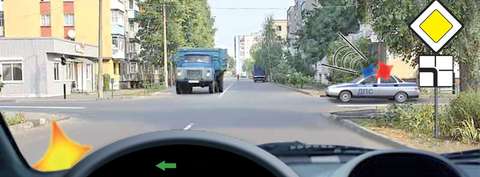
Correct answer: 2 Undoubtedly, the “operative” with a blue flasher and an activated siren has an advantage. Everyone else is required to provide him with unhindered passage of the intersection. After its passage you pass, as you are on the main road and have an advantage over the truck on the secondary road. (Clauses 3.1, 13.9 of the SDA).
Who do you have to give way to when turning left?
Question 105.
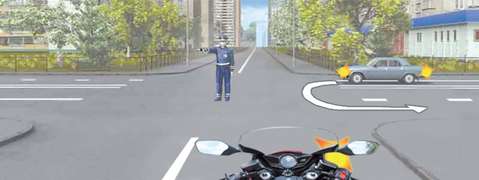
Correct answer: 3 From the side of the outstretched right hand of the traffic controller, rail vehicles are only allowed to move to the right. In this case, the unfolding car, guided by the "rule of the right hand," gives way to you. (Clause 6.10 of the SDA).
You intend to turn right. Your actions?
Question 106.
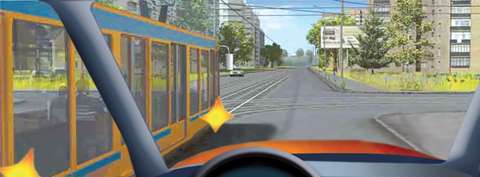
Correct answer: 3 You and the tram are on the same road in equal conditions. In this case, the tram always has an advantage over trackless vehicles. You must give way to the tram in both of these cases. (Clause 13.11 of the SDA).
When should you give way to a tram?
Question 107.
![]()
Correct answer: 2 The intersection is unregulated, unequal. The advantage is the vehicles located on the main road, which are guided by the "right-hand rule". After passing the intersection, vehicles located on a secondary road. The truck passes by first, you concede to it. The last one to pass a car. (Clauses 13.3, 13.9, 13.12 of the SDA).
Question 108.

Correct answer: 2 When turning right or left at any intersection (regulated, unregulated), the driver must give way to pedestrians crossing the carriageway he turns on. The correct answer is the second. (Clauses 6.2, 13.1 of the SDA).
What should you do when turning right?
Question 109.

Correct answer: 3 The intersection is equivalent. Drivers are guided by the “right-hand rule”. You have no interference on the right, in any direction of the above. Pass the intersection first. (Clause 13.11 of the SDA).
When moving in which direction will you have an advantage?
Question 110.

Correct answer: 2 The intersection is not equal. You and the tram are on the main road. The "rule of the right hand" in this case does not work. An equivalent tram has an advantage over trackless vehicles. Give way to the tram. (Clause 13.11 of the SDA, "Traffic Signs").
You intend to continue straight ahead. Your actions:
Question 111.

Correct answer: 3 The intersection is adjustable. Priority signs “do not work”. “Operative” with special signals departs from the requirements of traffic signals. Other drivers are required to ensure unhindered travel. When turning left, you must give way to a passenger car moving straight from the opposite direction. (Clauses 3.1, 3.2, 13.3, 13.4 of the SDA).
What should you do when turning left?
Question 112.
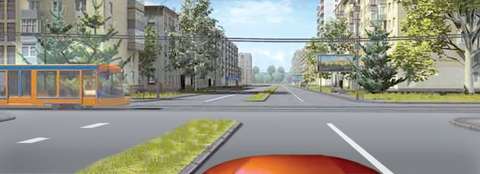
Correct answer: 3 The intersection is equivalent. You and the tram are in equal conditions. In this case, the tram always has an advantage over trackless vehicles. (Clause 13.11 of the SDA).
When driving in which direction are you obliged to give way to the tram?
Question 113.

Correct answer: 2 The intersection is not equal. Sign 2.4 obliges you to give way to vehicles moving on a crossed road. Only after you make sure that the truck really turns left and your movement cannot interfere with it, do you go to the intersection to make a right turn. (Clauses 1.2, 13.9 of the SDA, "Road Signs").
You intend to turn right. Can you start the turn?
Question 114.
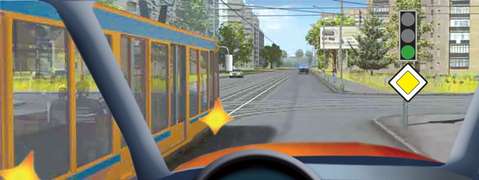
Correct answer: 3 The intersection is regulated by a traffic light. Priority signs “do not work”. You and the tram are in equal conditions. Tram in such situations always has an advantage over trackless vehicles, so you give way to the tram. (Clause 13.6 of the SDA).
You intend to drive the intersection in the forward direction. Your actions?
Question 115.

Correct answer: 1 An intersection is equivalent. Drivers of trackless vehicles are guided by the “right-hand rule”, i.e. who has a hindrance on the right, he gives way. You have a hindrance on the right, the car drives first. (Clause 13.11 of the SDA).
What is the characteristic intersection of equivalent roads? There are no traffic lights or priority signs.
Everyone has an equal right to travel!
And with an equal right to travel, the general principle of interference on the right always comes into effect.
The essence of this principle is that if only the trajectories intersect, the one to whom the vehicle is approaching on the right should give way. By itself, this principle is simple and understandable if everyone moves straight. A little harder when you need to turn or turn around. Here, perhaps, we will begin with turns.
Right turn.
|
You must give way to a truck: 1. Only when driving straight. 2. Only when turning right. 3. In both of these cases. Commentary on the task
Truck for you interference on the right! If you intend to move straight, you must give way to him. But if you intend to turn right, then the trajectories do not intersect. There is no one to give way!
Trajectories intersect if the truck starts to turn around. But in this case, in the final phase of the turn, we will become an obstacle to the truck on the right. That is, in this situation, we can boldly turn right, there is no one to give way! |
|
1. Pass the intersection first. 2. Give way to a car. 3. Commentary on the task
The same thing here - you can safely turn right. You do not intersect with the motorcycle, and the oncoming one must give you the way (by the principle of interference on the right). Initially, there was no interference on the right, but it arose in the process of moving through the intersection. |
|
1. Must give way to both vehicles. 2. Must give way only to the car. 3. You have an advantage over both vehicles. Commentary on the task Rules. Clause 13.11 / 1. Now your duty is to give way to those in the circle. |
More about turning right there are no problems. Let's try to drive straight.
|
1. Give way to a truck. 2. Take the intersection first. 3. Act by mutual agreement with the truck driver. Commentary on the task There are no priority signs, and, it seems, this is a crossroads of equivalent roads. But this is a roundabout! And about the roundabout, the Rules spoke separately: Rules. Clause 13.11 / 1. At the entrance to the intersection at which the roundabout is organized and which is marked with the sign 4.3, the driver of the vehicle must give way to vehicles moving at such an intersection. In this situation, moving in a circle, you have an advantage over everyone entering it. |
There are no more problems about the movement. There was only a left turn and a U-turn.
Left turn.
|
1. Pass the intersection first. 2. Pass the intersection simultaneously with the oncoming car until the motorcycle passes. 3. Pass the intersection last. Commentary on the task Here events will develop as follows. Only the oncoming car does not have interference on the right; it will be the first to drive. And if you were moving directly or to the right, he should have given way to you at the intersection. But you have left turn indicators turned on, the paths of your movements do not intersect, so in this situation, the oncoming one will pass the intersection without stopping. Then the motorcyclist will pass by, and only after that it will be your turn to start moving. |
|
1. Pass the intersection first. 2. Drive to the intersection and, giving way to the motorcyclist, complete the turn. 3. Give way to both vehicles. Commentary on the task There is no interference on the right just with you, only you can drive into the intersection. If you were moving straight or to the right, you would have crossed the intersection without stopping. But you intend to turn left and, therefore, you will need to stop at the intersection in order to give way to the motorcycle (it moves straight ahead - no direction indicators are turned on, and the paths of your movements intersect). At the same time (as soon as you entered the intersection), the obstacle to the right of the driver of the car disappeared. He left, the obstacle on the right of the motorcyclist disappeared. He left, and only now you can finally complete your left turn. Note! The last intersection you left, but only the motorcyclist was second only to the road! |
|
1. Give way to both trucks. 2. Upon reaching the intersection, give way to an oncoming truck and complete the turn. 3. Pass the intersection first. Commentary on the task Both paved roads are a crossroads of equivalent roads! And, therefore, the oncoming truck will pass first (only it has no interference on the right), then the truck will turn on with the yellow flashing light (it will stop the interference on the right), and only after that you can start your turn to the left. |
There is nothing more about a left turn.
Now at the crossroads of equivalent roads we will try to turn around.
|
1. Turn around first. 2. Drive to the intersection and, give way to a passenger car, complete the U-turn. 3. You will act by mutual agreement with the driver of the car. Commentary on the task Now you have no interference on the right, you can proceed to a U-turn.
Interference on the right will occur in the final phase of the U-turn and, therefore, when completing a U-turn, do not forget give way to him. |
|
1. Only when driving straight. 2. When driving straight and left. 3. When driving straight and left and in the opposite direction. Commentary on the task
The situation is almost the same as in the previous task. Accordingly, the actions will be the same. If we go straight or left, we have an advantage. If we begin to unfold, then in the final phase of the reversal we will have to give way to him. |
And now you will see an extraordinary task. The problem with such a "filling" appeared for the first time. This has never happened before. And she appeared on September 1, 2016.
Let's talk about it especially.
|
1. Reject the advantage in movement and proceed with a U-turn after passing a car. 2. Drive to the intersection first and, giving way to a passenger car, complete the U-turn. 3. Both options are allowed. Commentary on the task In fact, the situation is the same as in the previous task. Only now we are not going straight or left, but we are turning around.
In the final phase of the reversal, it will become an obstacle to us on the right. Therefore, having entered the intersection, we must give way to it. But why then the correct answer is the third !? “Since the car is on the left, you can go to the crossroads of equivalent roads first. When you turn around, the car will become “a hindrance to the right” for you and you will need to skip it, and then finish the turn. With this in mind, you can abandon the advantage in movement and start a U-turn after passing this car ». That is, the authors of this comment argue like this - since it’s all the same, upon entering the intersection you have to give way, is it not better to give way right away. Let him leave, and then I will calmly turn around at an empty intersection. Remember this task so as not to make a mistake here. After all, the Rules do not say anywhere that drivers are forbidden to give up their pre-emptive right to priority travel. And what is not prohibited is allowed. |
There is nothing more about a U-turn.
But there is another interesting problem when four vehicles came together at the intersection.
Task 23
|
1. The driver of the trolley bus. 2. You and the trolley bus driver. 3. In this situation, the order of travel is determined by mutual agreement of the drivers. |
What is characteristic of an adjustable intersection!
Here, equal access rights are granted to those who have the main green traffic light turned on.
With equal right to travel, drivers of trackless vehicles understand each other
according to the general principle of "interference on the right."
Task 1
Task 2
|
1. Drive first. 2. Give way only to an oncoming car. 3. Give way only to a car with a flashing beacon on and a special sound signal. 4. Commentary on the task Now, on the contrary, you are moving straight, and the truck is turning left from the oncoming direction. It is clear that he must give way to you. But first, do not forget to miss the car with the flashing beacon on and a special sound signal. |
Task 3
|
1. Take the intersection first. 2. Drive out of the stop line and stop at the intersection to give way to an oncoming car. 3. Stop in front of the stop-line and turn left after passing the car. Commentary on the task All the same. The authors of the examination collection have not yet proposed anything new to us. Just do not stop in front of the stop line, the green light is on for you! Feel free to drive into the intersection and already there, at the intersection, give way to the oncoming one. And one more important point! You do not have to see what is on fire at the oncoming one. You can be sure - if you are green, then it is exactly the same green. |
Task 4
|
1. When turning left. 2. When reversing. 3. Commentary on the task For the fourth time in a row, they ask you if you know this requirement of the Rules: Rules. Section 13. Clause 13.4. When turning left or turning on a green traffic light, the driver of a track-less vehicle must give way to vehicles moving from the opposite direction straight and to the right. And this requirement of the Rules is fully consistent with our universal principle: With equal right to travel, drivers of non-rail vehicles understand each other according to the general principle of “interference on the right”.
In the process of turning to the left (or turning), the oncoming vehicle becomes for you "an obstacle to the right." And there, at the intersection, where there is interference on the right, it is necessary to give way to the oncoming one. Note.
Ticket Authors occasionally defamate slightly, provoking you to make a mistake. In this task, in fact, all three answers are correct. If you hurry up and do not finish reading to the end, you can choose something wrong. The first two answers lack the word “only” - ( Only
when turning left; Only
when turning). Then it is clear that both answers are wrong. In life, you will not be mistaken, but be careful at the exam - in order not to make a stupid mistake, always read all the answers to the end. |
But nothing new for us. All the same:
With equal right to travel, drivers of non-rail vehicles
understand each other according to the general principle of “interference on the right”,
and the tram has an advantage regardless of the direction of movement.
Task 5
Task 6
Task 7
Task 8
Task 9
|
1. Must give way to both vehicles. 2. Must give way only to a passenger car. 3. You have the right to pass the intersection first. Commentary on the task Everyone hasequal right to travel (all move to the main green traffic light).
Of course, turning left, you will have to give way and the tram, and this is the oncoming car that is barely visible in this figure. |
Task 10
|
1. When turning left. 2. When driving straight. 3. In both of these cases. Commentary on the task Both (you and the tram) are moving towards the green traffic light, that is, both have equal right to travel. And with equal right to travel, a tram always has an advantage regardless of the direction of travel. Note. Here again! - the authors of the Tickets accidentally (well, it happened) forgot to put the word “only” at the beginning of the first two answers. And again! - all three answers are correct. And once again I repeat - in life you will not be mistaken, but here, on the exam, adapt to the enemy. Both forgetfulness and carelessness are allowed to him, and you will not be forgiven for any carelessness during the exam. |
Task 11
|
1. Give way to the tram. 2. Wait for the permission signal of the special traffic light and, passing the tram, turn left. 3. Pass the intersection first. Commentary on the task Separate regulation is applied at this intersection - you have your own traffic light, the tram driver has his own. In such cases, the signals of these two traffic lights must not contradict each other. If your traffic light allows you to move in all directions (as now in the picture), then a signal should be turned on at a special traffic light that prohibits the movement of the tram. Look at the picture, the way it is - a prohibition signal is turned on at a special traffic light. So do not stand, drive through the intersection, while the green light is on for you. |
Task 12
|
1. Pass the intersection first. 2. Give way to the tram. Commentary on the task The same thing here. With this signal, a special traffic light is allowed only directly. And he needs to the right, and the tram will stand, waiting for a signal allowing a turn to the right. But you don’t have to stand, drive through the intersection, while the green light is on for you.
With separate regulation, you can be sure that when the tram turns on a signal allowing rotation to the right, the red light will turn on.
Or maybe your traffic light will have an extra section with an arrow to the right. Then in this situation you can turn right at the same time as the tram (trajectories do not intersect). |
As for the traffic lights equipped with additional sections, we also need to talk about them separately.
Task 13
|
1. Only when turning left. 2. Only with a U-turn. 3. When performing any of the maneuvers listed. green signal has full right to travel. The driver moving on the "arrow", included simultaneously with the main in red signal has incomplete right to travel. He is obliged to give way to all whom he sees at the intersection.
The text of the question does not say that truck and bus drivers are moving to the “arrow” with the main red. Note that in life you will not see what is included in the bus and truck. In life, you will have other landmarks:
Firstly, you can be 100% sure that the bus is switched on the main red (since green for you, it means that in the transverse direction it will definitely be red). As for oncoming traffic, here the picture will be like this - on all lanes (except the extreme right) the cars are motionless! And it is only with the extreme right that the people are trying to "leak out" without interfering with you. In life, that’s how you’ll guess that the oncoming is on basic red (with the green arrow to the right). And you are moving on the arrow withthe main green! You have an unconditional advantage. |
Task 14
Task 15
|
1. Are required. 2. Not required. Commentary on the task If the driver turns on the green arrow in the additional section together with the main red light He is the last person at this crossroads. You can move in the direction of the arrow, but giving way to everyone. Figuratively speaking, one can only “leak out” carefully, without creating any interference to anyone. Here's how the Rules say it: Rules. Section 13. Clause 13.5. When driving in the direction of the arrow, which is included in the additional section at the same time as the yellow or red traffic signal, the driver must give way to vehicles moving from other directions. |
Task 16
|
1. Stop in front of the stop line. 2. Continue driving, giving way to a passenger car. 3. Continue driving, taking precedence over a passenger car. Commentary on the task At the T-shaped intersections in the additional section of the traffic light, the arrow will be shown “straight”. But fundamentally this does not change anything. You can move straight. But in this situation it’s not just possible, but, giving way to a passenger car. You will go to basic redand he moves on primary green! |
Together with a traffic light before the intersection, various signs and markings may be present, which establish a certain order of movement. And, of course, the requirements of signs and markings must be followed.
The only exception is priority signs.
Priority signs conflict with traffic signals,
and here’s what the Rules say about this:
Rules. Section 6. Clause 6.15. Second paragraph.If the values \u200b\u200bof traffic signals contradict the requirements of priority traffic signs, drivers should be guided by traffic signals.
Task 17
|
1. Must stop in front of the stop line. 2. You can continue driving through the intersection without stopping. 3. Must give way to vehicles moving from other directions. Commentary on the task
When the traffic light is running, the traffic sequence is set only by traffic signals! You - green, of course, you can continue to move without stopping. Figuratively speaking, with a running traffic light, priority signs “die”.
Priority signs “come to life” if the traffic light is turned off or put into yellow flashing mode. Then the intersection will become unregulated, and here (with this sign!) Do not forget to stop at the stop line. You can continue driving only after the driver evaluates the situation on the intersected road. |
Task 18
Task 19
|
What traffic signs are canceled by traffic signals? 1. Priority signs. 2. Prohibition signs. 3. Warning signs. 4. All of these. Commentary on the task Only priority signs conflict with traffic signals, therefore only they “die” when the traffic light is working. All other signs are “alive and healthy” and act, as they should.
After all, you will not turn left if one-way traffic is organized on the intersected road. |
So, when the traffic light is on, we do not look at priority signs!
Driving order is set only by traffic signals!
Task 20
|
1. Only a motorcycle. 2. Only for a car with a flashing light and a special sound signal. 3. Both vehicles. Commentary on the task It is clear that the first intersection will pass the car with the flashing beacon on and a special sound signal. Well, then everything is as usual. We with the motorcyclist have an equal right to drive (he, like us, moves to the green traffic light). Therefore, turning left, we must give way to him. |
Task 21
|
1. Pass the intersection first. 2. Give way only to a car with a flashing light and a special sound signal. 3. Give way to both vehicles. Commentary on the task Everything is the same here - we give way to both the “beacon” and the oncoming car (it, like us, moves to the green traffic light). And you do not look at the priority signs, they are not here now. Now it adjustable intersection! |
And that when the traffic light does not need to look at the priority signs, you will be asked 4 more times!
Task 22
|
1. Only to pedestrians. 2. Only to the bus. 3. Bus and pedestrians. Commentary on the task
The traffic light works, and there is no main road here. If it’s green to you, then it means that it’s also green. Naturally, turning left, you must give way to the bus. Well, to pedestrians, of course. |
Task 23
|
1. Drive first, guided by a traffic light. 2. Pass first, guided by the sign "Main Road". 3. Give way to the tram. Commentary on the task Now it’s an adjustable intersection (there is a green signal at the traffic light!) And, therefore, both (you and the tram) have equal right to travel. And with equal right to travel, the tram has an advantage regardless of the direction of movement.
By the way, in this situation, nothing will change if the traffic light is switched to the yellow flashing signal mode. The crossroads will become unregulated, priority signs will come to life, now both you and the tram are on the main road. And with equal right to travel, a tram always has an advantage regardless of the direction of travel. |
Task 24
|
1. Take the intersection first. 2. Give way only to a truck with a flashing light on. 3. Give way only to the bus. Commentary on the task Oh, how do you want, for every fireman, to give way to everyone - after all, a sign! But what is lit at the traffic light? Lit green. So the truck is on red. So we only deal with the oncoming bus. He’s right, we’ll go to the left - we’ll have to give way to him. |
Task 25
|
1. Are required. 2. Obligated if the car turns left. 3. Not required. Commentary on the task
The traffic light is working, it is an adjustable intersection, both are moving to a green signal - both equal right to travel . So deal with him on the principle of "interference on the right." |
And there will be 8 problems with the traffic controller.
If there is an adjuster at the intersection, this is even more an adjustable intersection. In this case, drivers should not only not look at priority signs, they should not look at traffic signals. It is only necessary to look at the traffic controller and follow only his instructions.
Traffic controller - the main person on the road!
It cancels both the action of priority signs and the action of traffic signals.
True, in the problems that the authors of the Tickets have offered you, there are no priority signs or traffic lights.
They just check you - do you know the signals of the traffic controller?
Task 26
|
1. Turn right without giving way to pedestrians. 2. Turn right, giving way to pedestrians. 3. Stop in front of the intersection and wait for another signal from the traffic controller. Commentary on the task Such a signal of the traffic controller allows you to move straight and to the right. Well, and enter the intersection. Only, turning to the right, it is necessary to give way to pedestrians. By the way, with such a signal from the traffic controller, they have every right to make the transition. |
Task 27
|
1. Stop and wait for another signal from the traffic controller. 2. Turn right, giving way to pedestrians. 3. Turn right, taking precedence over pedestrians. |
Question 73:
1. Only a motorcycle.
2. Only for a car with a flashing light and a special sound signal.
At regulated intersections, the sequence of traffic is determined not by priority signs, but by traffic signals in clause 6.15 and clause 13.3. In addition, you need to skip the car with the blue flashing light on and a special sound signal in clause 3.2 of the SDA. When turning left, it is necessary to give way to a motorcyclist moving in the opposite direction directly to paragraph 13.4 of the SDA.
Question 74:

2. Skip the car with the flashing beacon on and a special sound signal.
Even if there is no interference at the crossroads of equal roads on the right of clause 13.11, you must give way to a car with a blue flashing light and a special sound signal in clause 3.2.
Question 75:

When turning left into the second passage, you:
1. Have an advantage.
2. Must give way to a car and a bus.
3. Must give way only to the bus.
You and the bus driver are on the main road (sign "Main road"), and therefore, when turning left, you must give way to the bus at 13.12. You have an advantage over a passenger car, as it is located on a secondary road, paragraph 13.9.
Question 76:

If you intend to continue straight ahead, you must:
1. Drive through the intersection first.
2. Give way to the tram.
You and the tram are on the main road, and therefore, when determining the order of passage for this intersection, you should be guided by the fact that the tram has an advantage over trackless vehicles moving in the opposite or opposite direction on an equivalent road regardless of the direction of movement of clause 13.9.
Question 77:

When turning left, you must:
1. Give way to a car.
Guided by the rules of passage of intersections of equivalent roads, you must give way to a passenger car, as it approaches the right p. 13.11.
Question 78:

Are you allowed to turn right?
1. Yes, giving way to pedestrians.
2. No.
In the case when the traffic controller is located to you on the left or right side, and his arms are lowered or extended to the sides, you are allowed to move directly and to the right p. 6.10. However, turning to the right, you should give way to pedestrians crossing the carriageway, onto which you turn p. 13.1.
Question 79:
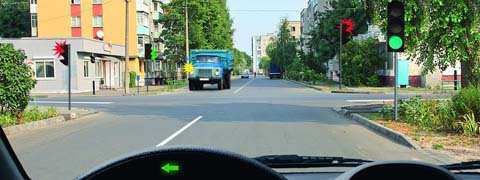
You intend to turn left. Should I give way to a truck?
1. Yes.
2. No.
When turning left at the traffic light enable signal, you must give way to the oncoming truck, turning right to p. 13.4.
Question 80:

1. Make sure that there are no pedestrians completing the passage of the carriageway, and then start driving.
2. Guided by a traffic signal, immediately start driving.
Before you start driving when the green traffic light is turned on, you must make sure that there are no pedestrians completing the passage of the carriageway, which may appear due to the truck on the right p. 13.8.
Question 81:
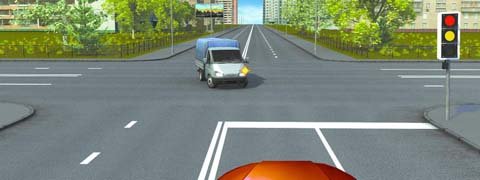
When you turn on the green traffic light, you must:
1. Give way to a truck completing a U-turn at an intersection.
2. Start driving without giving way to a truck.
You must give way to a truck that has not had time to complete a U-turn at the intersection of clause 13.8.
Question 82:

With a yellow flashing traffic light, moving straight, you must:
1. Stop and continue driving only after turning on the green traffic light.
2. Make way for the horse-drawn carriage.
3. Drive through the intersection with the oncoming car.
With a yellow flashing traffic light, the intersection is considered unregulated in clause 13.3, and therefore you must, in accordance with the rules for driving on intersections of equal roads, give way to a horse-drawn cart approaching to the right of clause 13.11.
Question 83:

You intend to drive the intersection in the forward direction. Who should give way?
1. Only tram.
3. Both vehicles.
At this intersection of equivalent roads, you must give way only to the tram that has an advantage, and the car on the left passes the intersection after you, as it must give you the way to 13.11.
Question 84:
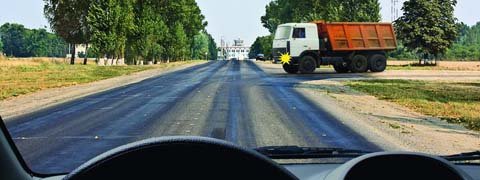
You intend to drive the intersection in the forward direction. Should I give way to a truck driving off a dirt road?
1. Yes.
2. No.
At this intersection, even though the truck is on the right, you are not required to give way to it. The fact is that you are moving along a paved road, which is the main one in relation to the dirt road, on which there is a truck p. 13.9 and p. 1.2, the term "main road".
Question 85:
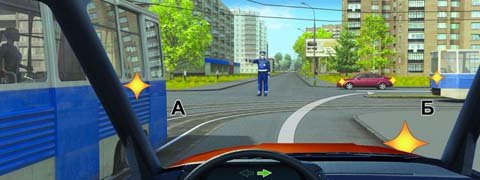
1. Give way only to tram A.
2. Give way only to tram B.
3. Give way to both trams.
4. Pass the intersection first.
Such a signal from the traffic controller gives the right to traffic to you and tram drivers in clause 6.10. And since you need to cross tram tracks to turn right, you must give way to both trams in clause 13.6.
Question 86:
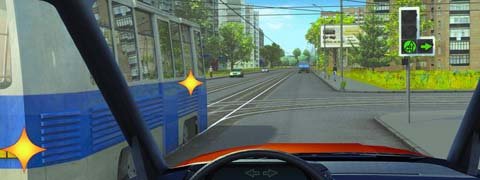
2. Give way to the tram.
The included turn indicator informs you that the paths of your car and tram intersect at the intersection. Given that this traffic light simultaneously allows you and the tram driver to move, you must give way to the tram in clause 6.2 and clause 13.6.
Question 87:

You intend to turn left. Who should give way?
1. Tram A and a passenger car.
2. Only tram A.
3. All vehicles.
4. No one.
Moving at this intersection in the direction of the main road (signs "Main road" and "Direction of the main road"), in order to determine the sequence of travel with tram A and a car, you must follow the rules for traveling on intersections of equivalent roads in clause 13.10 of the SDA. In accordance with them, the tram A p. 13.11 of the SDA has the advantage. According to the same rules, the car located on your left is obliged to give way. The tram B, which runs along the secondary road of section 13.9 of the SDA, is also inferior to you.
Question 88:
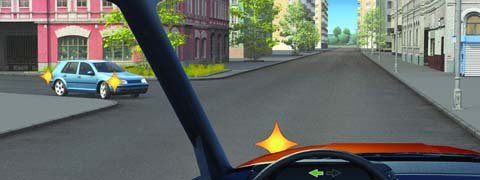
You intend to turn around. Your actions?
1. Turn around first.
2. Drive to the intersection and, giving way to the car, complete the U-turn.
The order of intersections of equivalent roads does not depend on the configuration of intersections. In this situation, you will go to the intersection and, giving way to a car that will be to your right at 13.11, complete the U-turn.
Question 89:
![]()
What should be done in this situation if you need to turn right?
1. Stop in front of the intersection and, after waiting for another signal from the traffic controller, turn right.
2. You can turn right, giving way to pedestrians.
If the traffic controller is facing you with his left side, and his right hand is stretched forward, you are allowed to move in all directions: straight, right, left, in the opposite direction, clause 6.10. However, when turning right, you should give way to pedestrians crossing the carriageway, onto which you turn p. 13.1.
Question 90:
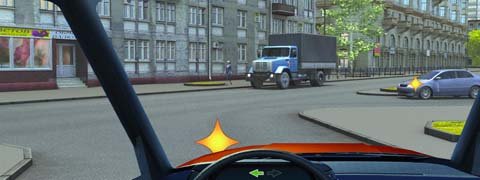
You intend to turn left. To whom should you give way?
1. Both vehicles.
2. Only to the truck.
3. Only for a passenger car.
Regardless of the configuration of the intersection of equivalent roads, the general driving order is maintained, and when you turn left, you must give way to both vehicles located to your right, clause 13.11 and clause 13.12.
Question 91:

This hand signal from a motorcyclist informs you:
1. About his intention to continue straight ahead.
2. About his intention to turn right.
3. His intention to slow down in order to stop and give way to a passenger car.
The braking signal given by the motorcyclist’s left hand raised indicates his intention to reduce speed in order to stop at 8.1 and give way to a passenger car approaching an unregulated intersection of equivalent roads on the right to 13.11 on the right.
Question 92:
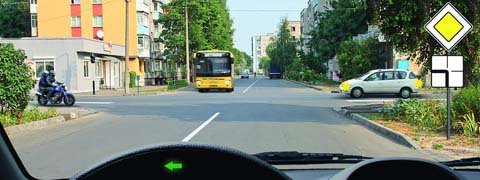
You intend to turn left. Who should give way?
1. Only to the bus.
2. Passenger car and bus.
3. Only a motorcycle.
4. No one.
Passing this intersection of unequal roads in the direction of the main road (the signs “Main road” and “Direction of the main road”), you take advantage not only of the bus and passenger car of section 13.9 on the secondary road, but also of the motorcycle, which, like You are moving along the main road and for which you are an “obstacle to the right” of clause 13.10 and clause 13.11. The correct answer is Nobody.
Question 93:
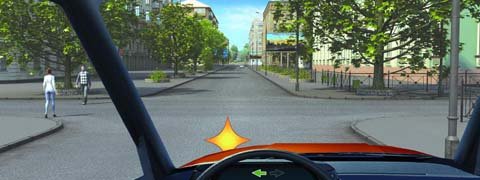
1. Give way to pedestrians.
2. Pass the intersection without giving way to pedestrians.
Turning left at this intersection, you should give way to pedestrians crossing the carriageway, onto which you turn p. 13.1.
Question 94:
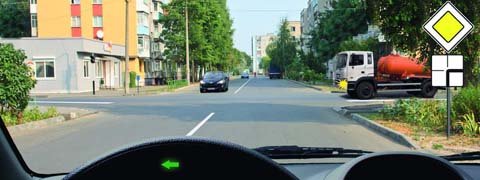
You intend to turn around. To whom should you give way?
1. Only to the truck.
2. Only for a passenger car.
3. Both vehicles.
In this case, you are on the main road (signs “Main road” and “Direction of the main road”) and have an advantage over a passenger car regardless of the direction of your further movement, clause 13.9. But with respect to the truck, also located on the main road, the rules for the passage of intersections of equivalent roads of Section 13.10 apply, according to which you must give way to it, since it approaches the right of Section 13.11.
Question 95:
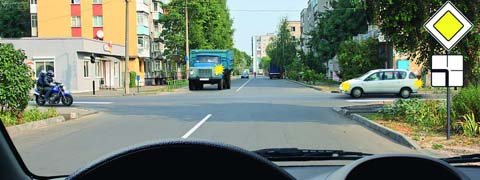
1. Only a motorcycle.
2. Motorcycle and passenger car.
3. To no one.
When entering the intersection of unequal roads on the main road (signs "Main road" and "Direction of the main road"), you take advantage of trucks and cars located on secondary roads of section 13.9. With a motorcycle, which also enters the intersection along the main road, you drive off according to the rules for driving intersections of equivalent roads, having in this case the advantage of clause 13.10 and clause 13.11. So you should not give way to anyone.
Question 96:
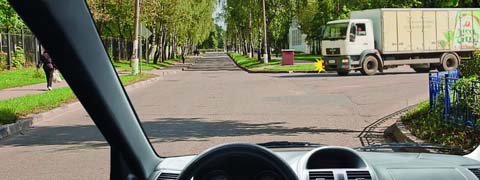
In order to continue moving in the forward direction, you must:
1. Drive through the intersection first.
2. Make way for the truck.
You must give way to a truck approaching on the right, as you pass a crossroad of equivalent roads in clause 13.11. In this case, the configuration of the intersection does not matter.
Question 97:

You intend to turn left. Your actions?
1. Drive through the intersection first.
2. Give way only to a car with a flashing light and a special sound signal.
3. Give way to both vehicles.
This intersection is adjustable, and the sequence of traffic on it is determined not by priority signs, but by traffic signals in clause 6.15 and clause 13.3. However, despite the traffic light permitting signal, you must give way to the car with the blue flashing light on and a special sound signal moving along the intersected road in Section 3.2. Turning left, you must give way to a car moving from the opposite direction of paragraph 13.4.
Question 98:
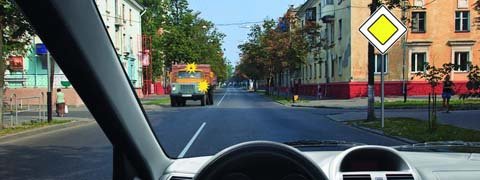
You intend to drive the intersection in the forward direction. Do you have to give way to an oncoming car with a flashing light on?
1. Yes.
2. No.
When driving through a crossroads of unequal roads in the direction of the main road (sign) in the forward direction, you take precedence over an oncoming car turning left to 13.12, since an orange or yellow flashing light does not give preference to traffic in 3.4.
Question 99:
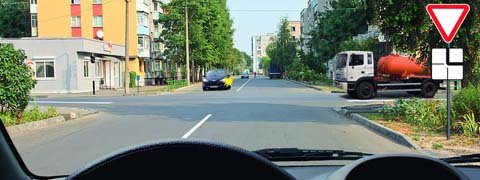
You intend to continue straight ahead. Who should give way?
1. Only for a passenger car.
3. Both vehicles.
Since you are on a secondary road (the signs “Give way” and “Direction of the main road”), you can pass the intersection of unequal roads, giving way to both vehicles that are moving along the main road at 13.9.
Question 100:
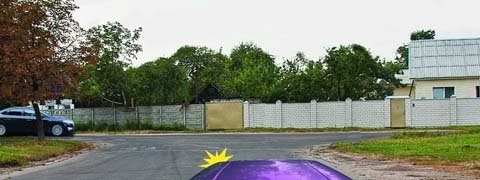
Turning left, you must:
1. Make way for the car.
2. Drive through the intersection first.
At the intersection of these roads, you have an advantage over the driver of the car on the left, which should give way to equivalent roads at paragraph 13.11.
Question 101:

You intend to turn right. Your actions?
1. Stop in front of the stop line and, skipping pedestrians, turn right.
2. Upon reaching the intersection, stop in front of the pedestrian crossing to let pedestrians pass.
3. Continue without stopping at the intersection.
You can go to the intersection with a traffic light. However, turning right, you must stop in front of the pedestrian crossing and give way to pedestrians crossing the carriageway, onto which you turn p. 13.1.
Question 102:
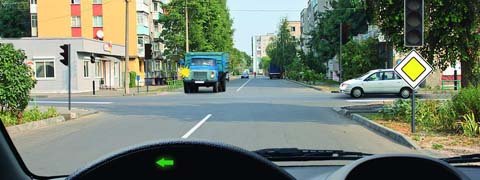
If you intend to turn left, you must:
1. Give way to a truck.
2. Give way to both vehicles.
3. Drive through the intersection first.
When the traffic lights are off, the intersection is considered unregulated and drivers should be guided by the priority signs in clause 13.3. The truck, just like you, is located on the main road (the sign "Main road"), and therefore, turning left, you must give way to it in clause 13.12. In relation to a passenger car, you take advantage, as it drives up to the intersection on a secondary road, paragraph 13.9.
Question 103:

You intend to drive the intersection in the forward direction. Your actions?
1. Give way to a passenger car because it was the first to drive into an intersection.
2. Make sure that the car gives way, and pass the intersection first.
Despite the fact that the car was the first to enter the intersection of equivalent roads, you have an advantage over it, and its driver, when you turn left, must give you the way to paragraph 13.11 and paragraph 13.12.
Question 104:

You intend to turn right. Your actions?
1. Drive through the intersection first.
2. Give way only to a passenger car.
3. Give way to a car and a motorcycle.
You will pass the intersection of equivalent roads first, since there are no vehicles to your right that would need to give way to 13.11.
Question 105:
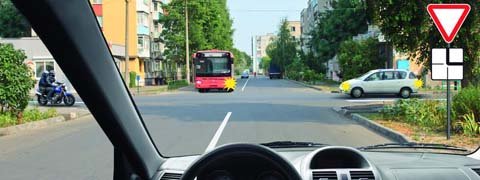
You intend to continue straight ahead. Who should give way?
1. Only for a passenger car.
2. Only to the bus and the car.
3. All vehicles.
Since you are approaching the intersection on a secondary road (the signs “Give way” and “Direction of the main road”), you must give way to the bus and passenger car, section 13.9. In relation to the motorcycle, you take advantage, since both are on minor roads of clause 13.10 and clause 13.11.
Question 106:

When driving straight, you:
1. Have an advantage.
2. Must give way only to a motorcycle.
3. Must give way only to the car.
4. Must give way to both vehicles.
An orange or yellow flashing light does not give an advantage in traffic, and, being guided by the rules for driving on crossroads of equal roads, you must give way only to a motorcycle approaching to the right of clause 3.4 and clause 13.11.
Question 107:

You intend to drive the intersection in the forward direction. Your actions?
1. Drive through the intersection first.
2. Give way only by tram.
3. Give way to the tram and car.
The green traffic signal gives the right to drive you and the oncoming vehicle in clause 6.2. In this case, you must give way only to tram n. 13.6. The oncoming passenger car cannot cross the intersection with the tram. Clause 13.4 is not entitled.
Question 108:

You intend to turn left. Who should give way?
1. Only to the bus.
2. Only to the truck.
3. Both vehicles.
Since the “Give way” sign is set in front of the intersection, you, moving along a secondary road, must, in accordance with the rules for driving crossroads of unequal roads, give way to both vehicles in clause 13.9.
Question 1:
1. Only tram A.
2. Only tram B.
3. Both trams.
4. No one.
In this situation, you must give way to both trams, since at the crossroads of equivalent roads the tram has an advantage over trackless vehicles regardless of its direction of travel, clause 13.11.
Question 2:

You intend to continue moving forward. Should you give way to a truck?
1. Yes.
2. No.
The presence of the “Dead End” sign does not change the order of passage of intersections of equivalent roads, according to which you must give way to a truck approaching the right of paragraph 13.11.
Question 3:
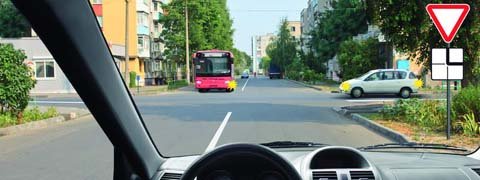
1. Both vehicles.
2. Only for a passenger car.
3. Only to the bus.
This is a crossroads of unequal roads (“Give way” and “Main road direction” signs). The main road at the intersection changes direction. You approach a crossroads on a secondary road and, therefore, are obliged to give way to both vehicles moving along the main road, regardless of the direction of their movement, clause 13.9 of the SDA.
Question 4:

1. Yes.
2. No.
You must give way to the tram on the left, as at the crossroads of equivalent roads the tram has an advantage over trackless vehicles regardless of the direction of its movement, clause 13.11.
Question 5:

You intend to drive the intersection in the forward direction. Should you give way to a truck?
1. Yes.
2. No.
Guided by the rules for driving through unregulated intersections of equivalent roads, you must give way to the truck approaching on the right to Section 13.11, which, in turn, giving way to the tram, still has the right to leave for the intersected roadway.
Question 6:

You intend to drive the intersection in the forward direction. Your actions?
1. Stop in front of the stop line.
2. Continue driving without interfering with the passenger car.
When moving in the direction of the arrow, which is included in the additional section at the same time as the red traffic light, you must give way to vehicles moving from any other directions of clause 13.5. But in this situation, moving along the right lane, you can continue to move without stopping in front of the stop line if you do not interfere with the movement of the car.
Question 7:

You intend to continue straight ahead. Your actions?
1. Complete the intersection if you are the first to cross it.
2. Make way for the truck.
Despite the fact that you were the first to enter the crossroads of equivalent roads and approached the dividing strip, you must give way to the truck approaching to the right on p. 13.11.
Question 8:

You intend to continue moving forward. Your actions?
2. Continue driving only after leaving at the intersection of a car.
At the intersection of equivalent roads, you must give way to a passenger car approaching on the right, and therefore you can continue driving in the forward direction only after this vehicle leaves at the intersection of 13.11.
Question 9:
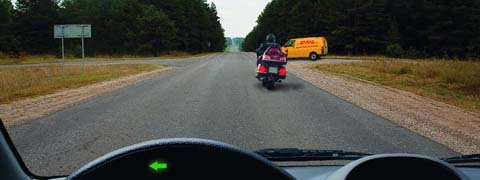
Are you allowed to overtake a motorcyclist?
1. Allowed.
2. Forbidden.
The motorcyclist and you are approaching an unregulated intersection of equivalent roads, on which overtaking is prohibited in clause 11.4. In addition, there is a car to your right, to which both drivers must give way to 13.11.
Question 10:

1. Drive through the intersection first.
2. Give way only to a truck with a flashing light on.
3. Give way only to the bus.
This intersection is adjustable, and the sequence of movement on it is determined not by priority signs, but by traffic signals in paragraph 6.15 and
paragraph 13.3. Turning left, you must give way to a bus moving from the oncoming direction directly to paragraph 13.4. A truck with an orange flashing light turned on does not have the advantage in crossing lanes in Section 3.4, so its driver must wait for a traffic light permitting signal.
Question 11:

1. Only for a passenger car.
2. Passenger car and bus.
3. To no one.
At this crossroads of unequal roads (signs “Main road” and “Direction of the main road”), you must give way only to a passenger car to the right, which, like you, is moving along the main road, and therefore you need to drive away according to the rules of passage of intersections of equivalent roads, clause 13.10 and clause 13.11. The motorcycle and the bus give way to you, as they approach the intersection on the secondary roads of clause 13.9.
Question 12:
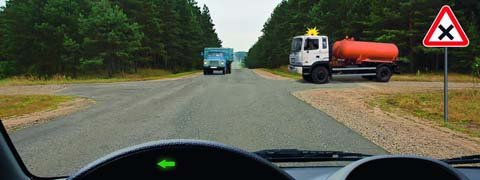
You intend to turn left. Your actions?
1. Give way to both trucks.
2. Having reached the intersection, give way to the oncoming truck and complete the turn.
The sign “Crossing equivalent roads”, even if the intersected road is unpaved, indicates that there is a crossroad of equivalent roads in front of you. You must give way to both cars: a truck with a yellow (orange) beacon, since it is on your right, and an oncoming truck, because it moves directly to paragraph 13.11 and paragraph 13.12.
Question 13:

You intend to continue straight ahead. Who should give way?
1. Only tram.
3. Tram and car.
4. To all vehicles.
At this intersection of unequal roads, where the main road changes direction (signs “Main road” and “Direction of the main road”), the sequence of driving with a tram and a car is determined by the rules for driving intersections of equivalent roads, since you and they are on the main road . 13.9 and clause 13.10. In accordance with these rules, the road should be ceded to a tram that turns right and to a passenger car, paragraph 13.11. In relation to the motorcycle, you take advantage, since it is located on a secondary road p. 13.9.
Question 14:

This sign warns of approaching the intersection where you:
1. Have the right of preferential travel.
2. Must give way to all vehicles moving on a crossed road.
3. Must give way only to vehicles approaching on the right.
The sign "Crossing equivalent roads", installed in settlements 50-100 m to the dangerous section, indicates that there is a crossroads at a sharp turn where you must give way to the vehicle approaching the right of paragraph 13.11.
Question 15:
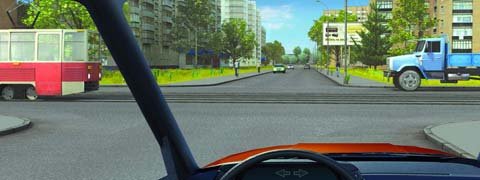
You intend to drive the intersection in the forward direction. Who should give way?
1. Only tram.
2. Only to the truck.
At the intersection of equivalent roads, you must give way to the truck on the right, as well as to the tram, which takes precedence regardless of the direction of its movement, clause 13.11.
Question 16:

In which case you do not have to give way to other road users?
1. Only if you intend to continue straight ahead.
2. Only if you intend to continue driving straight or to the right.
3. In any case.
The green traffic light permits you to go and I am in paragraph 6.2. At the same time, if you intend to move to the left or in the opposite direction at this intersection, you will have to give way to the tram at n. 13.6, and when turning right, to pedestrians at n. 13.1. Thus, only when driving straight ahead does not need anyone to give way.
Question 17:

These signs, placed in front of the intersection, mean that:
1. Being at such an intersection, you will have to give way to all vehicles entering it.
2. Being at such an intersection, you will have an advantage over all vehicles entering it.
The combination of the traffic sign "Roundabout" with the sign "Give way" or the sign "No stopping is prohibited" means that drivers who are at a roundabout with a roundabout take advantage of vehicles entering it in Section 13.9. Being at such an intersection, you enjoy the preferential right of way.
Question 18:
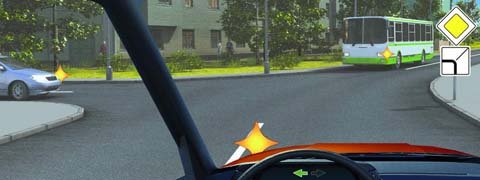
You intend to turn left. Who should give way?
1. Only to the bus.
2. Only for a passenger car.
3. To no one.
Turning left in the direction of the main road (signs "Main road" and "Direction of the main road") at the intersection of unequal roads, you take advantage of the bus, which is located on the secondary road, section 13.9. The car is also located on the main road, but it moves to your left, and according to the rules for driving at intersections of equivalent roads, clause 13.10 and clause 13.11, you have an advantage over it.
Question 19:
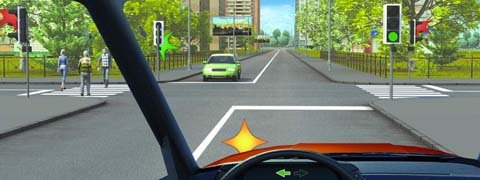
You intend to turn left. Who should give way?
1. Only the oncoming car.
2. Only for pedestrians.
3. Oncoming car and pedestrians.
Turning left at the traffic light enable signal, you must give way to an oncoming car moving straight at 13.4, and completing a turn also to pedestrians crossing the carriageway you turn at 13.1.
Question 20:
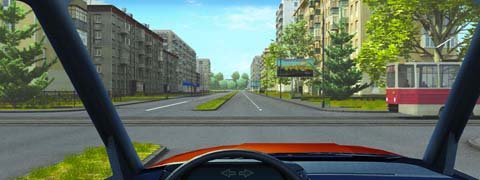
Should the tram directly give way to traffic?
1. Yes.
2. No.
Despite the fact that you are moving along a road with a dividing strip, in the absence of priority signs it is equal in value to the intersected one. Guided by the rules of passage of intersections of equivalent roads, you must give way to the tram p. 13.11.
Question 21:

You intend to turn left. Who should give way?
1. No one.
2. Only for a car with a flashing light and a special sound signal.
3. Both vehicles.
Moving along the main road (signs “Main road” and “Direction of the main road”), you could pass this intersection of unequal roads by the first paragraph 13.9. However, the presence of a car on the right with a blue flashing light and a special sound signal changes the situation, and you must give way to it in clause 3.2.
Question 22:
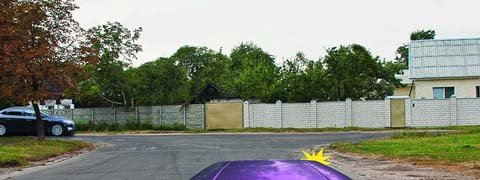
Turning to the right, you must:
1. Make way for the car.
2. Drive through the intersection first.
You pass the intersection of equivalent roads first, since the car is on your left and its driver must give way to 13.11. In this case, the configuration of the intersection does not matter.
Question 23:

You intend to turn left. Your actions?
1. Drive through the intersection first.
2. Give way to the car.
The passenger car on the left should give you the way to 13.11, and therefore you will pass the intersection of equivalent roads first. In this case, the configuration of the intersection does not affect the sequence of movement.
Question 24:
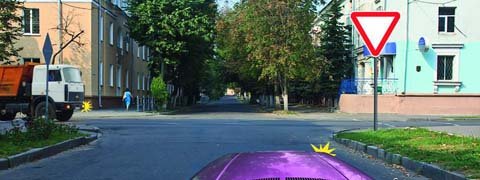
1. Yes.
2. Yes, after the truck starts turning.
3. None.
The “Give way” sign requires that you give way to a truck approaching a crossroads of unequal roads on a crossed road. Since the concept of “Make way” in paragraph 1.2 does not require a mandatory stop, you can start turning right, as soon as you make sure that the truck really turns left. At the same time, during the entire maneuver, you should not create obstacles for its movement p. 13.9.
Question 25:
Are you allowed to continue driving if the traffic controller raised his hand after you entered the intersection?
1. Not allowed.
2. Allowed only if you turn right.
3. Allowed.
Since you have already entered the intersection, you must continue to move and leave it in the direction of your choice in paragraph 13.7 and paragraph 6.14.
Question 26:

You intend to turn right. Can you start the turn?
1. Yes.
2. Yes, but without interfering with the truck.
3. None.
The “Give way” sign obliges you to give way to a truck at this intersection of unequal roads, without requiring a mandatory stop before the intersection of paragraph 1.2, the term “Give way”. As the truck moves along the left lane farther away from you, you can begin to turn right. However, at the same time, during the entire maneuver, you should not interfere with the movement of the truck in clause 13.9.
Question 27:
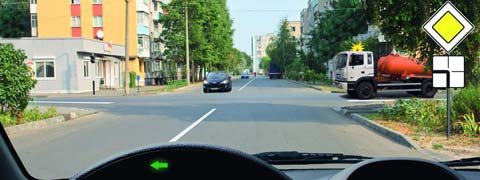
You intend to turn left. Your actions?
1. Drive through the intersection first.
2. Give way only to a truck with a flashing light on.
3. Give way to both vehicles.
Flashing beacon of orange or yellow color does not give advantages in movement p. 3.4. Therefore, moving along the main road (signs “Main road” and “Direction of the main road”), you can pass this intersection of unequal roads first. A passenger car and a lorry with a beacon are located on minor roads and must give you the way to Section 13.9.
Question 28:
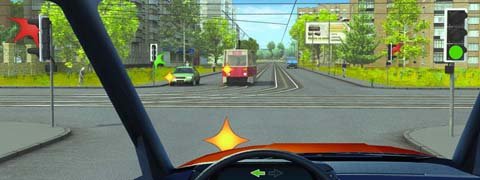
You intend to turn left. Who should give way?
1. Only to the car.
2. Only tram.
3. Car and tram.
4. No one.
The green traffic signal gives the right to drive you and the oncoming vehicle in paragraph 6.2. At the same time, turning left, you must give way to the tram in clause 13.6 and a passenger car turning to the right in clause 13.4.
Question 29:
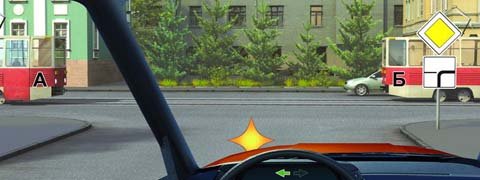
You intend to turn left. Who should give way?
1. Only to trams.
2. Tram B and a car.
3. All vehicles.
At this crossroads of unequal roads (signs “Main road” and “Direction of the main road”) you must give way to tram B and a passenger car, which, like you, are on the main road and are for you “an obstacle to the right”. With them you drive away according to the rules of passage of intersections of equivalent roads of clause 13.10 and clause 13.11. Before the tram And you have an advantage, because it moves along the secondary road p. 13.9.
Question 30:
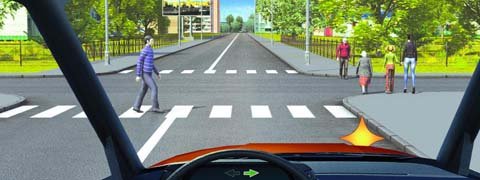
1. Give way only to a pedestrian crossing a carriageway at an unregulated pedestrian crossing.
2. Give way only to pedestrians crossing the carriageway that you are turning onto.
3. Give way to all pedestrians.
In this situation, you must give way to both the pedestrian crossing it at the unregulated pedestrian crossing at p. 14.1 and the pedestrians on the right crossing the carriageway that you turn at at the intersection of p. 13.1.
Question 31:
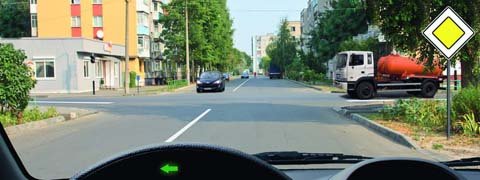
You intend to turn around. Your actions?
1. Give way only to a passenger car and turn around.
2. Give way to both vehicles and turn around.
At this intersection of unequal roads, a passenger car, like you, is on the main road (the sign "Main road"), and when you turn around, you must give way to it in clause 13.12. In relation to the truck you take advantage, since it is located on the secondary road of clause 13.9.
Question 32:

You intend to turn left. Your actions?
1. Give way to the tram.
2. Pass the intersection first.
You must give way to the tram, which at the crossroads of equivalent roads has an advantage over trackless vehicles of clause 13.11.
Question 33:
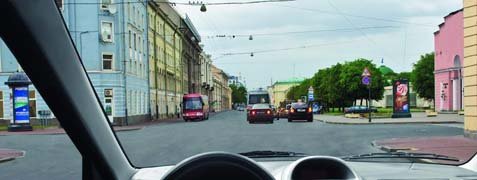
You have the right to go to the intersection if there is a traffic jam behind it:
1. Only if you intend to cross the intersection in the forward direction.
2. Only if you intend to make a turn or U-turn.
3. In any case.
In this situation, you can go to the intersection only for turning or turning, since the resulting traffic jam makes it impossible to move in the forward direction without a forced stop at the intersection, and this will create an obstacle to movement in the transverse direction of clause 13.2.
Question 34:

You intend to turn right. Your actions?
1. Drive through the intersection first.
2. Give way to both trams.
3. Give way only to tram A.
4. Give way only to tram B.
Such a traffic signal gives the right to traffic to you and the tram drivers of clause 6.2. And since you need to cross tram tracks to turn right, you must give way to both trams in clause 13.6.
Question 35:

When turning right, you must give way:
1. Only to the cyclist.
2. Only for pedestrians.
3. Pedestrians and cyclists.
4. No one.
When turning right at the traffic light enable signal, you must give way to both the cyclist and pedestrians in section 13.1.
Question 36:

This road sign:
1. Warns of approaching the intersection with the tram line.
2. Warns of approaching a tram stop.
3. Obliges you to stop immediately before the intersection with the tram line.
The sign "Intersection with a tram line" is set in front of all intersections of a road with tram tracks outside the intersection, as well as in front of intersections along which tram lines pass if the visibility of these routes (for example, due to a turn of the road) is less than 50 m. In the event you must be prepared to give way to the tram n. 18.1 and n. 13.11.



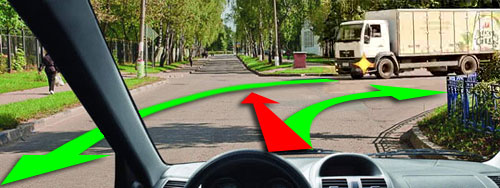

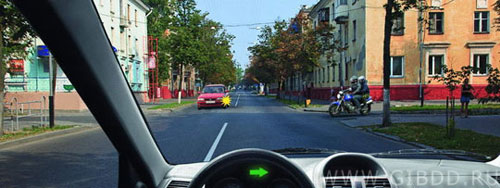 You intend to turn right. Your actions?
You intend to turn right. Your actions?
 When entering an intersection you:
When entering an intersection you: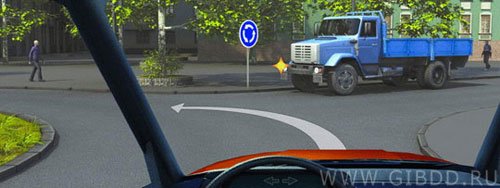 What should you do when moving in a roundabout?
What should you do when moving in a roundabout?
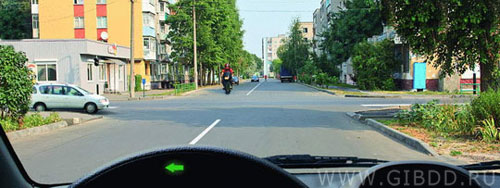 You intend to turn left. Your actions?
You intend to turn left. Your actions?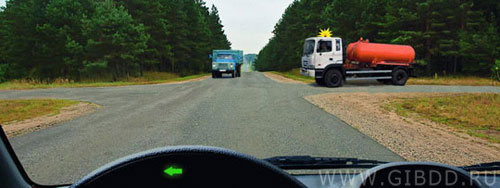 You intend to turn left. Your actions?
You intend to turn left. Your actions? You intend to turn around. Your actions?
You intend to turn around. Your actions?
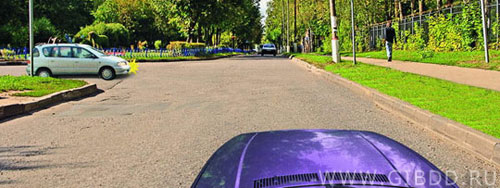 In which case do you have the right to cross the intersection first?
In which case do you have the right to cross the intersection first?
 You intend to complete a U-turn. What are your possible actions?
You intend to complete a U-turn. What are your possible actions?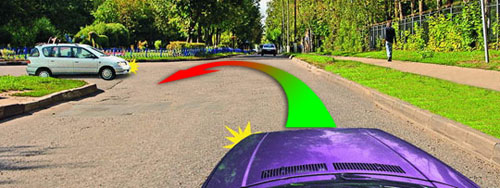
 Who has the right to cross the intersection first if everyone intends to move straight ahead?
Who has the right to cross the intersection first if everyone intends to move straight ahead? You intend to drive the intersection in the forward direction. Your actions?
You intend to drive the intersection in the forward direction. Your actions?
 In which case are you obliged to give way to a truck?
In which case are you obliged to give way to a truck?
 When turning left, you:
When turning left, you:
 In which case are you obliged to give way to the tram?
In which case are you obliged to give way to the tram? You intend to turn left. Your actions?
You intend to turn left. Your actions?


 When performing a maneuver, does a car driver have an advantage in driving?
When performing a maneuver, does a car driver have an advantage in driving?

 Do you have to turn right when giving way to a U-turn vehicle?
Do you have to turn right when giving way to a U-turn vehicle? You intend to cross the intersection in the forward direction. Your actions?
You intend to cross the intersection in the forward direction. Your actions? When driving straight, you:
When driving straight, you:


 To whom should you give way when turning left?
To whom should you give way when turning left? What should you do when turning left?
What should you do when turning left? You intend to turn left. Who should give way?
You intend to turn left. Who should give way?
 You intend to cross the intersection in the forward direction. Your actions?
You intend to cross the intersection in the forward direction. Your actions?
 What should you do when turning left?
What should you do when turning left? Are you obligated to give way to a passenger car when turning right?
Are you obligated to give way to a passenger car when turning right?
 You intend to turn right. Your actions?
You intend to turn right. Your actions? What should be done in this situation if you need to turn right?
What should be done in this situation if you need to turn right?